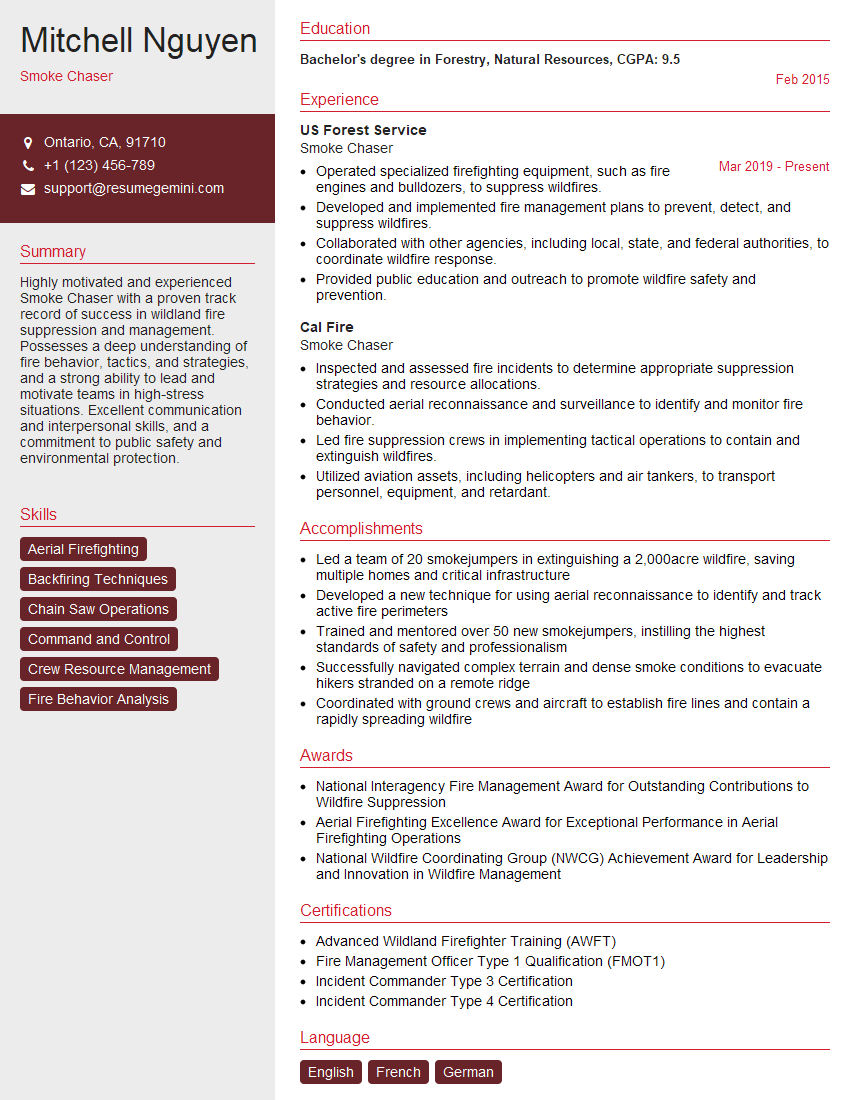Are you a seasoned Smoke Chaser seeking a new career path? Discover our professionally built Smoke Chaser Resume Template. This time-saving tool provides a solid foundation for your job search. Simply click “Edit Resume” to customize it with your unique experiences and achievements. Customize fonts and colors to match your personal style and increase your chances of landing your dream job. Explore more Resume Templates for additional options.

Mitchell Nguyen
Smoke Chaser
Summary
Highly motivated and experienced Smoke Chaser with a proven track record of success in wildland fire suppression and management. Possesses a deep understanding of fire behavior, tactics, and strategies, and a strong ability to lead and motivate teams in high-stress situations. Excellent communication and interpersonal skills, and a commitment to public safety and environmental protection.
Education
Bachelor’s degree in Forestry, Natural Resources
February 2015
Skills
- Aerial Firefighting
- Backfiring Techniques
- Chain Saw Operations
- Command and Control
- Crew Resource Management
- Fire Behavior Analysis
Work Experience
Smoke Chaser
- Operated specialized firefighting equipment, such as fire engines and bulldozers, to suppress wildfires.
- Developed and implemented fire management plans to prevent, detect, and suppress wildfires.
- Collaborated with other agencies, including local, state, and federal authorities, to coordinate wildfire response.
- Provided public education and outreach to promote wildfire safety and prevention.
Smoke Chaser
- Inspected and assessed fire incidents to determine appropriate suppression strategies and resource allocations.
- Conducted aerial reconnaissance and surveillance to identify and monitor fire behavior.
- Led fire suppression crews in implementing tactical operations to contain and extinguish wildfires.
- Utilized aviation assets, including helicopters and air tankers, to transport personnel, equipment, and retardant.
Accomplishments
- Led a team of 20 smokejumpers in extinguishing a 2,000acre wildfire, saving multiple homes and critical infrastructure
- Developed a new technique for using aerial reconnaissance to identify and track active fire perimeters
- Trained and mentored over 50 new smokejumpers, instilling the highest standards of safety and professionalism
- Successfully navigated complex terrain and dense smoke conditions to evacuate hikers stranded on a remote ridge
- Coordinated with ground crews and aircraft to establish fire lines and contain a rapidly spreading wildfire
Awards
- National Interagency Fire Management Award for Outstanding Contributions to Wildfire Suppression
- Aerial Firefighting Excellence Award for Exceptional Performance in Aerial Firefighting Operations
- National Wildfire Coordinating Group (NWCG) Achievement Award for Leadership and Innovation in Wildfire Management
Certificates
- Advanced Wildland Firefighter Training (AWFT)
- Fire Management Officer Type 1 Qualification (FMOT1)
- Incident Commander Type 3 Certification
- Incident Commander Type 4 Certification
Career Expert Tips:
- Select the ideal resume template to showcase your professional experience effectively.
- Master the art of resume writing to highlight your unique qualifications and achievements.
- Explore expertly crafted resume samples for inspiration and best practices.
- Build your best resume for free this new year with ResumeGemini. Enjoy exclusive discounts on ATS optimized resume templates.
How To Write Resume For Smoke Chaser
- Quantify your accomplishments by providing specific metrics and results whenever possible.
- Highlight your experience in aerial firefighting, backfiring techniques, and chain saw operations.
- Showcase your leadership and management skills by describing your role in coordinating and motivating fire suppression crews.
- Emphasize your commitment to public safety and environmental protection by discussing your involvement in outreach and education programs.
Essential Experience Highlights for a Strong Smoke Chaser Resume
- Inspected and assessed fire incidents to determine appropriate suppression strategies and resource allocations.
- Conducted aerial reconnaissance and surveillance to identify and monitor fire behavior.
- Led fire suppression crews in implementing tactical operations to contain and extinguish wildfires.
- Utilized aviation assets, including helicopters and air tankers, to transport personnel, equipment, and retardant.
- Operated specialized firefighting equipment, such as fire engines and bulldozers, to suppress wildfires.
- Developed and implemented fire management plans to prevent, detect, and suppress wildfires.
- Collaborated with other agencies, including local, state, and federal authorities, to coordinate wildfire response.
Frequently Asked Questions (FAQ’s) For Smoke Chaser
What are the key skills and qualifications for a Smoke Chaser?
Smoke Chasers typically need a bachelor’s degree in forestry, natural resources, or a related field, as well as experience in wildland fire suppression and management. They must be physically fit, have strong leadership and communication skills, and be able to work independently and as part of a team.
What is the job outlook for Smoke Chasers?
The job outlook for Smoke Chasers is expected to be good over the next few years. As wildfires become more frequent and severe due to climate change, there will be an increasing need for trained professionals to suppress and manage these fires.
What is the average salary for a Smoke Chaser?
The average salary for a Smoke Chaser is around $50,000 per year. However, salaries can vary depending on experience, location, and employer.
What are the benefits of being a Smoke Chaser?
Smoke Chasers enjoy a number of benefits, including competitive salaries, paid time off, and health insurance. They also have the opportunity to work outdoors, help protect communities from wildfires, and make a difference in the environment.
What are the challenges of being a Smoke Chaser?
Smoke Chasers face a number of challenges, including long hours, dangerous working conditions, and exposure to smoke and other hazardous materials. They must also be able to work independently and make quick decisions in high-stress situations.